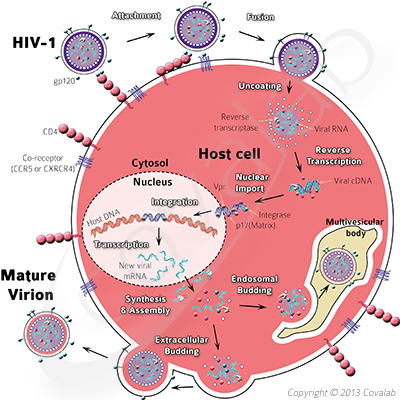We use cookies to make your experience better. To comply with the new e-Privacy directive, we need to ask for your consent to set the cookies. Learn more.
Virology
Virology-related products from Covalab
Like living cells, viruses have a genome comprised of nucleic acids, either DNA or RNA, with a coat of unique proteins wrapped around that genome; therefore each virus can be identified as belonging to a particular “species”. But unlike living cells, viruses do not produce their own energy (metabolism) nor do they replicate (reproduction) independently of a host cell.
Viruses can only replicate within another living cell, using its “machinery”. After a virus has invaded a host organism, it enters a cell and hijacks its organelles, tricking them into forming a viral assembly line that creates several new virus particles, usually killing the cell in the process. Some viruses send out their progeny a few at a time whilst others push the cell to produce so many viral progeny that it bursts, expelling new particles that then invade neighbouring cells, repeating the process.
Viruses penetrate cells via interaction with specific receptors expressed by the host cell. These receptors determine the host and tissue tropism of the virus.
Knowing how viruses interact with host cells helps us to study their origin and how to develop new strategies for potential vaccination or treatment. Appearance of new dangerous viruses like the hCoV-EMC — novel human coronavirus — makes the discovery of how viruses infect cells a priority. For other viruses like HIV, 30 years of research are still not enough to find a way to cure AIDS. Although the mechanisms used by the virus are characterised in many aspects (fig 1), there are still lots of things to discover to eradicate these public enemies that are viruses.
To help researchers every day in this challenge, CovalAb offers a wide range of specific antibodies against viral proteins from several families.
Browse our complete Virology-related products range!
Download Files

Download our dedicated brochure and find what you need among our virology-related products!
References:
- 1 - Crawford D.H., Oxford Univ Press Inc NY (2001)
- 2 - Raj V.S. et al., Nature 495, 251-254 (2013)

